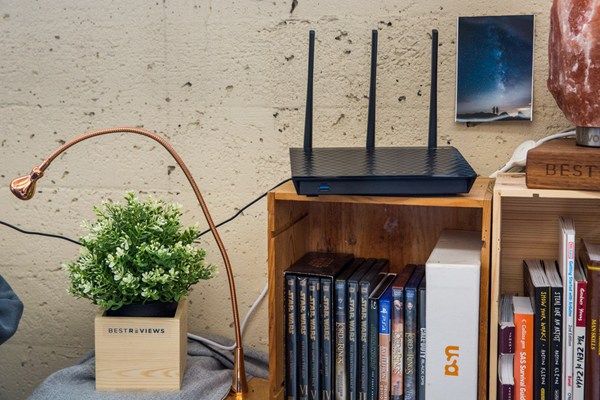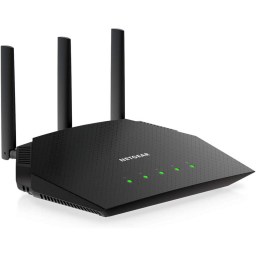Buying guide for Best wireless routers
There are a lot of different ways to set up WiFi in your home, but the most traditional method is to use a wireless router. Wireless routers, sometimes referred to as WiFi routers, take the internet signal from your cable modem and make it available wirelessly to your other devices — so it’s critical to get one that’s both fast enough for all of your gear and secure enough to keep all of your content safe.
Wireless routers are perfect for homes where they can be placed in a centralized location: most models include multiple antennas to increase their broadcast range. Many models also work with WiFi extenders, so you can add coverage to specific problem areas.
What is a wireless router?
A wireless router is a device that translates the internet signal from a cable modem into a radio frequency signal—aka WiFi. Your wireless router handles all of your WiFi traffic and allows you to configure specific settings like your WiFi password or WiFi network name.
Most internet service providers (ISPs) offer modem/router combo units, but monthly rental fees add up quickly, so you should buy your own cable modem and wireless router as separate devices.
Expert Tip
If you own a lot of smart home devices, make sure to choose a router that broadcasts on both the 2.4GHz and 5.0GHz channels. Smart home devices typically run on the older 2.4GHz channel.
BestReviews Electronics Expert
WiFi terminology: a cheat sheet
Wireless routers are often described by a wide variety of terms, codes, and protocol names that are easy to confuse.
The Wi-Fi Alliance—a worldwide network of WiFi researchers and manufacturers—ratifies new WiFi standards as they become available. For example, the first mainstream WiFi technology was built based on the 802.11b protocol. Subsequent upgrades like 802.11g, 802.11n, 802.11a, 802.11ac, and the bleeding-edge WiFi 6 protocols have enabled WiFi to be faster and farther-reaching. Each new standard is backward-compatible with the ones that came before it. The bottom line: Most modern devices use the 802.11ac standard, and WiFi 6 adoption will be slow. In most cases, sticking with an 802.11ac wireless router is the best option.
Most modern wireless routers are dual-band, which means they broadcast at both the 2.4GHz and the 5.0GHz frequencies. That’s important because older devices and newer smart home devices will typically only work on the 2.4GHz band, and newer devices can take advantage of the less crowded 5.0GHz band. Some routers market themselves as “tri-band” routers, but that’s a bit of a misnomer; tri-band routers have an additional 5.0GHz broadcast. Tri-band routers are overkill for most people, but they can be helpful if you’re supporting several users and dozens of devices.
Expert Tip
If you’re not sure if you need WiFI 6 or not, check your devices--it’s likely that only your most current gear will be able to take advantage of WiFi 6 speeds.
BestReviews Electronics Expert
Some wireless routers are mesh networking systems, which offer similar features using a different delivery model. With a wireless router, you’re broadcasting your WiFi signal from one piece of hardware. With a mesh networking system, you use multiple nodes placed in different locations to create your WiFi network. Both traditional wireless routers and mesh networking systems can deliver fast WiFi to all of your devices; if you’re not sure which to buy, make the decision based on which approach is best for your home’s layout.
Parental controls come with most routers. This allows households with kids to find the most family-friendly option.
Consider a wireless router with a sleek and simple design. Such a router can easily fit into any space without becoming an eyesore.
Consider how easy each model is to set up. Most models can be configured through a smartphone app.
If you want to connect computers or other devices directly to the router, you will need a model with more than a few LAN ports. Bonus points go to routers with ample ports.
Consider how many GB each wireless router has per second, as this determines how fast your internet connection will be. Anything between 2GB and 11GB will be sufficient for daily internet use.
Consider one that connects with Alexa in our research, as this makes it easier to control your internet access. For example, with a simple voice command, you can quickly turn your WiFi off at dinnertime or connect or disconnect a guest network.
Consider security features offered by each wireless router, such as a firewall, intrusion detection, and daily security scans.
Some wireless routers include VPNs. Bonus points go to quality models that offer this feature, as it provides extra security.
Before shortlisting a wireless router, look at how many square feet it covers. In many cases, a quality router can cover at least 2,500 square feet.
Wireless router tips
-
The average wireless router covers about 2,500 square feet. If your home is larger than that, use a range extender or consider a mesh WiFi system.
-
If you want to connect computers or other devices directly to the router using an ethernet cable, make sure your chosen model has sufficient LAN ports.
-
Most wireless routers can be configured with a smartphone app. While you’re shopping, compare app store reviews of different companion apps to get a sense of what your experience will be like.
-
If your router has two external antennae, you'll get the best signal if one is pointed vertically and the other horizontally.
-
If you’re not sure if you need WiFI 6 or not, check your devices--it’s likely that only your most current gear will be able to take advantage of WiFi 6 speeds.
Expert Tip
Experiment with different placement to make sure you’re getting the best WiFi coverage available.
BestReviews Electronics Expert
Wireless router prices
The cost of a wireless router depends on the features and network standard.
Inexpensive
If you want a cheap router and you're not too concerned about speed, an 802.11n wireless router should cost between $20 and $50.
Mid-range
A basic 802.11ac router that will provide fast wireless connection and not much else will cost $40 to $80.
Expert Tip
If you’re a gamer, make sure the router you get supports key features like port forwarding and Quality of Service (QoS) controls. Advanced features like these can make sure your gaming experiences are lag-free.
BestReviews Electronics Expert
Expensive
Expect to pay $80 to $150 for a mid-range 802.11ac wireless router, with a few added extras like apps for remote access or Alexa compatibility.
High-end
The price of a high-end 802.11ac wireless router is roughly $150 to $350. These models should have a range of extra features, like a boosted signal range, multi-stage protection, game acceleration, and more.
FAQ
Q. How do I secure my wireless network?
A. There are a number of simple techniques that everyone should do to secure their wireless home network, such as:
- Turning on wireless network encryption.
- Ensuring that your wireless router’s firewall is turned on.
- Enabling MAC address filtering.
- Creating a custom name for your network.
- Setting your wireless router closer to the center of your home, so less of your WiFi signal will be detected outside of your property.
Q. My WiFi connection keeps dropping. How do I fix it?
A. If your wireless router isn’t reliably emitting the WiFi signal that it should be, there are a few quick fixes to test out:
- Reset your wireless router. (Sometimes the simplest solutions are the best).
- Reposition your router.
- Ensure that all cables are securely inserted into the router.
- Update your wireless router’s firmware.
- Call your internet provider and ask if there is an outage in your area.
Q. What is the best way to restart my wireless router?
A. Restarting your router is a common fix for wireless and connectivity issues, but there is a right and a wrong way to do so. Unless you want to turn your device back to its factory settings, do not push the “Reset” button on the back of your wireless router.
To restart your wireless router, simply unplug both your router and modem, and wait at least one minute. Plug in your modem, and wait another minute. Finally, plug your wireless router back in, and wait another minute or two to see if resetting your network connection fixed your problem.





















































